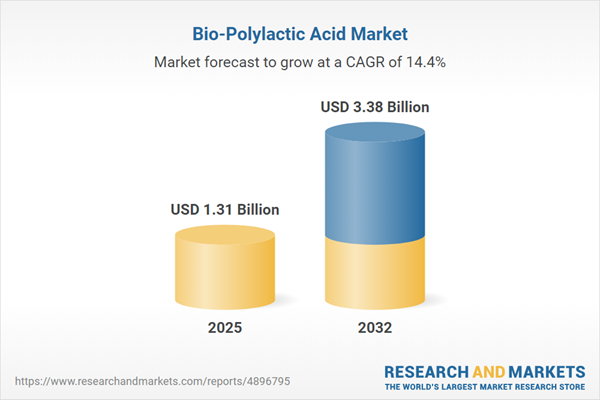Speak directly to the analyst to clarify any post sales queries you may have.
Organizations are accelerating the integration of sustainable solutions within procurement and supply chains in response to regulatory pressures. The bio-polylactic acid market provides a pathway for senior decision-makers to implement responsible sourcing strategies that maintain operational agility while advancing sustainability goals.
Market Snapshot: Bio-Polylactic Acid Market Overview
The global bio-polylactic acid market is valued at USD 1.15 billion in 2024 and is forecast to reach USD 1.31 billion by 2025, reflecting a compound annual growth rate (CAGR) of 14.36% through 2032. This segment demonstrates clear momentum as industries shift toward renewable materials and prioritize compliance with evolving sustainability mandates. Regulatory trends increasingly reward the adoption of biodegradable products and low-carbon alternatives. As a response, businesses are reshaping material sourcing to reduce risk and boost ESG performance. Advances in polymer processing and more supportive policy environments are further enhancing product flexibility and streamlining supply chain management. Key market participants are responding by investing in research, capacity expansion, and the establishment of more resilient sourcing models to strengthen procurement strategies for industrial buyers.
Scope & Segmentation: Navigating the Bio-Polylactic Acid Market
This report delivers actionable insights to senior executives focused on procurement, operations, and supply chain management, enabling tailored strategies for resilience and innovation within the bio-polylactic acid market:
- Source Types: Cassava, corn, sugarcane, and tapioca allow organizations to diversify agricultural procurement channels, reducing single-source dependency and supporting long-term stability.
- Process Technologies: Batch and continuous fermentation processes provide adaptive manufacturing options, supporting rapid volume shifts and operational responsiveness.
- Grade Classifications: Compounding, industrial, medical, and packaging grades target distinct compliance standards in regulated industries, helping stakeholders achieve product safety and adherence.
- Material Forms: Fiber, film, pellet, and powder types enable flexibility across production methods in industries such as textiles, automotive, and technical manufacturing.
- End Uses: Applications span agriculture, automotive, healthcare, packaging, consumer products, and textiles, supporting broad adoption and sectoral diversification.
- Application Modalities: Coatings, molded goods, and films ensure compatibility with varied commercialization and industry-specific requirements.
- Geographical Coverage: Analysis encompasses the Americas, Europe, Middle East & Africa, and Asia-Pacific, with regional opportunity mapping in the United States, China, Germany, and India for robust risk management frameworks.
- Leading Companies Profiled: Leading players such as NatureWorks LLC, TotalEnergies Corbion PLA S.A., and Mitsubishi Chemical Corporation exemplify supply network innovation and sector leadership.
Key Takeaways for Senior Leadership
- Adopting bio-polylactic acid can increase transparency across supply chains, supporting a shift to environmentally driven procurement strategies and regulatory compliance in multiple sectors.
- Advanced process technologies enable rapid adjustment to unforeseen challenges, helping teams remain agile and responsive to changing policy or operational needs.
- Diversifying agricultural input sources mitigates exposure to commodity and climate variabilities, bolstering resilience in raw material supply.
- Strategic alliances and joint ventures with suppliers enhance supply chain stability, jointly addressing risks related to economic or geopolitical uncertainties.
- Proactive regulatory engagement secures early compliance advantages, supporting differentiation where sustainability credentials and compostability influence procurement decisions.
- Access to a variety of grade classifications expedites product launches and helps meet technical demands in highly regulated markets.
Tariff Impact on Supply and Cost Structures
Recent tariff adjustments impacting key feedstocks have prompted organizations to develop deeper partnerships within their domestic regions. These regional alliances and joint sourcing initiatives help insulate supply chains from global trade disruptions. Under evolving trade policies, local supplier relationships and flexible contracting strategies are increasingly essential for continuity in operations and for reducing risk exposure.
Methodology & Data Sources
The research foundation combines direct interviews with senior executives, detailed regulatory analysis, corporate filings, and scrutiny of related patents. Ongoing market monitoring and comprehensive desk research strengthen the analytical depth, enabling robust and actionable recommendations tailored for executive leadership and procurement optimization.
Why This Report Matters: Strategic Benefits for Senior Leadership
- Extensive market segmentation and analytic tools equip executives to drive efficiency in procurement and develop enterprise-wide sustainability initiatives.
- Integrated risk assessment and benchmarking frameworks provide early visibility into regulatory or technological changes, aiding seamless adoption of renewable material sourcing strategies.
- Opportunity mapping and portfolio-level analysis inform business expansion and support long-term risk mitigation and sustainable growth initiatives.
Conclusion
Integrating bio-polylactic acid into sourcing and procurement supports strategic progress toward sustainability objectives. These market insights empower senior leaders to enhance supply networks and drive responsible, future-focused business growth.
Additional Product Information:
- Purchase of this report includes 1 year online access with quarterly updates.
- This report can be updated on request. Please contact our Customer Experience team using the Ask a Question widget on our website.
Table of Contents
3. Executive Summary
4. Market Overview
7. Cumulative Impact of Artificial Intelligence 2025
Companies Mentioned
The companies profiled in this Bio-Polylactic Acid market report include:- NatureWorks LLC
- TotalEnergies Corbion PLA S.A.
- Futerro SA
- Synbra Technology B.V.
- Teijin Limited
- Mitsubishi Chemical Corporation
- Sulzer Ltd.
- Nanjing Tianan Biological Material Co., Ltd.
- SpecialChem
- Unitika Ltd.
Table Information
| Report Attribute | Details |
|---|---|
| No. of Pages | 187 |
| Published | October 2025 |
| Forecast Period | 2025 - 2032 |
| Estimated Market Value ( USD | $ 1.31 Billion |
| Forecasted Market Value ( USD | $ 3.38 Billion |
| Compound Annual Growth Rate | 14.3% |
| Regions Covered | Global |
| No. of Companies Mentioned | 11 |









